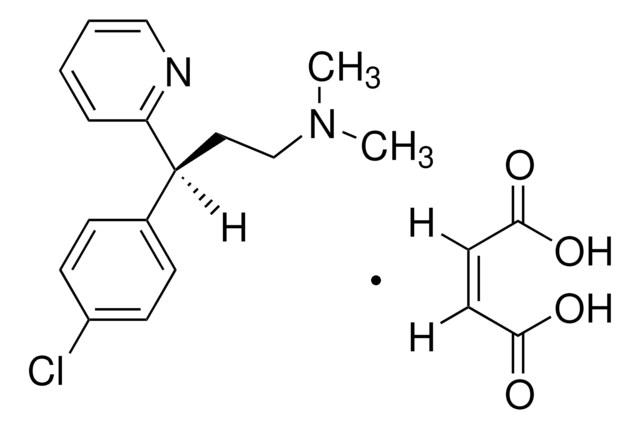C4915
S-(+)-Chlorpheniramine maleate salt
Sinónimos:
(S)-γ-(4-Chlorophenyl)-N,N-dimethyl-2-pyridinepropanamine maleate salt
About This Item
Productos recomendados
formulario
powder
Nivel de calidad
emisor
Bayer
cadena SMILES
[H]\C(=C(/[H])C(O)=O)C(O)=O.CN(C)CC[C@@H](c1ccc(Cl)cc1)c2ccccn2
InChI
1S/C16H19ClN2.C4H4O4/c1-19(2)12-10-15(16-5-3-4-11-18-16)13-6-8-14(17)9-7-13;5-3(6)1-2-4(7)8/h3-9,11,15H,10,12H2,1-2H3;1-2H,(H,5,6)(H,7,8)/b;2-1-/t15-;/m0./s1
Clave InChI
DBAKFASWICGISY-DASCVMRKSA-N
Información sobre el gen
human ... HRH1(3269)
¿Está buscando productos similares? Visita Guía de comparación de productos
Descripción general
Aplicación
Acciones bioquímicas o fisiológicas
Chlorpheniramine maleate is clinically used as a topical ointment to treat skin disorders such as sunburn, urticaria, angioedema, pruritus and insect bites.
Características y beneficios
Aplicación
Producto relacionado
Palabra de señalización
Danger
Frases de peligro
Consejos de prudencia
Clasificaciones de peligro
Acute Tox. 3 Oral
Código de clase de almacenamiento
6.1C - Combustible acute toxic Cat.3 / toxic compounds or compounds which causing chronic effects
Clase de riesgo para el agua (WGK)
WGK 3
Punto de inflamabilidad (°F)
Not applicable
Punto de inflamabilidad (°C)
Not applicable
Equipo de protección personal
Eyeshields, Faceshields, Gloves, type P2 (EN 143) respirator cartridges
Certificados de análisis (COA)
Busque Certificados de análisis (COA) introduciendo el número de lote del producto. Los números de lote se encuentran en la etiqueta del producto después de las palabras «Lot» o «Batch»
¿Ya tiene este producto?
Encuentre la documentación para los productos que ha comprado recientemente en la Biblioteca de documentos.
Chromatograms
application for HPLCapplication for SFCNuestro equipo de científicos tiene experiencia en todas las áreas de investigación: Ciencias de la vida, Ciencia de los materiales, Síntesis química, Cromatografía, Analítica y muchas otras.
Póngase en contacto con el Servicio técnico





